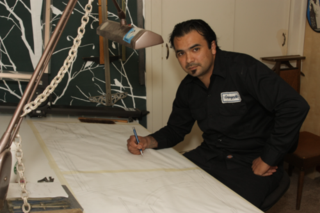by Timothy Rutt
A tough ex-Marine who doesn't like to quit isn't letting his disease keep him from the ranks of elite para-athletes -- and an Altadena bicycle maker is helping him realize his dream.
Kevan Brininger is a father of four who lives in Arizona. A former Marine corporal, Brinenger was medically discharged from the service in 1994 after suffering significant vision loss. The reasons were mysterious, but last year, as he lost muscle function, they found the culprit: multiple sclerosis."I've lost 90% of my vision, and lost the use of my lower extremities," Brinenger said recently in a phone interview. "I'm having episodes recently where I actually lost the use of both arms, but I went through a pretty intense steroid treatment, and have gotten the use [of my arms] back."
Taking to the road
But MS hasn't stopped him: Brinenger, who lives in Gilbert, Arizona, is an adaptive cyclist with AZ Disabled Sports, competing in the Tour de Tucson, a 42 mile race. His adaptive bike is ridden in a reclining position, using hand cranks to move forward.
Brininger is a lifelong cyclist: "I always loved cycling, the freedom to go out on the open road, just running. To be able to have that freedom is just huge for me I'm self-contained, I can do anything, and I'm pushing myself. I love the overall feeling I get from it." Brininger said it wasn't unusual to when he was younger to ride 150 miles from his home to Tucson, crash overnight, and ride back.
But moving into a hand bike meant more than the obvious changes. Brininger said that most hand bikes aren't built by bicycle manufacturers -- they're built by wheelchair companies out of wheelchair parts, which aren't as durable and are more expensive than bicycle parts. In fact, his current bike is in the shop because of a busted frame.
Brininger said that he was wondering how to get a durable hand bike that was closer to a bicycle than a wheelchair when he and his daughter saw a television documentary that featured James Romero at BlackSwift Bicycles in Altadena. Brininger said that his daughter pushed him to contact Romero: "Why don't you just email him and see what he can do?" she asked.
Romero responded. "I was just overwhelmed when I got an email back," Brenninger said. "He said he would consider doing it."
BlackSwift takes the challenge
Romero's BlackSwift handmade custom bicycles use durable steel tubing and top-of-the-line parts. The bikes are assembled and welded in Romero's Altadena garage. Each cycle is assembled based on the measurements and preferences of the buyer. Romero relished the challenge of assembling a hand bike, which he'd never done before.
"It's going to be a big challenge, just for the fact that I'm working around such unique parts and unique design," Romero said. Hand bikes tend to have to two looks, Romero said: "cheap and ugly, or space-age and bulky." He says one of the challenges is making the BlackSwift bike look like neither of those styles.
Brininger said that a more bicycle-oriented hand bike was what he was looking for -- the BlackSwift is "going to be more of a lifetime bike. Some of those aluminum ones, I've found out, aren't up to that. Some of those hand bike users change bikes every six months, but they're sponsored by the wheelchair companies, and I'm not. I'm just a little guy who wants to go out and see what I can do against the big boys."
Romero's bike will put Brininger in a sitting position, with his legs folded up under. They are exploring using fiberglass or carbon fiber for the seat pan and leg supports. Brinninger will turn the crank mostly by using his trunk muscles, moving up and down as his hands hold the cranks that propel the front wheel.
Cutting-edge design
Brininger's cycle must abide by the rules of the Union Cycliste Internationale (UCI), which governs paracycling events. Romero said that it's not hard, but it requires an extra layer of difficulty. As he's developing the design, he said, "we'll eventually need the draft bumper and some minute things that need to be done for it. One of the things we're questioning [UCI] on is if we can use a carbon drive rather than a chain." Romero's design uses a carbon fiber belt, similar to the belts that go on car engines, to propel the front tire, rather than a standard bicycle chain.
But even with such advanced features, one of the advantages to the bike is that many parts can be replaced at the local bike shop, rather than have to be special-ordered and shipped from a wheelchair company. "You can go to any bike shop, no matter where it is, and they'll have tubes and tires," Romero said.
When all is said and done, Romero estimates that the price of the bike will be around $6,500. While Brininger is paying for it himself, Romero has included a donation button on his website to help Brininger out. "Everything there kind of relieves the burden on him," Romero said.
Romero said that, while he relishes the design and build challenge, he plans on this to be his only hand bike. But: "If another comes along, I'm not going to turn it down."
As for Brininger, he is working with another company to build another chair to replicate running. His goal: to compete in the Iron Man triathalon. "I want to compete against able-bodied competitiors," he said. "I don't want to let my disability define who I am."
To help build Brininger's bike, click on the link here.





